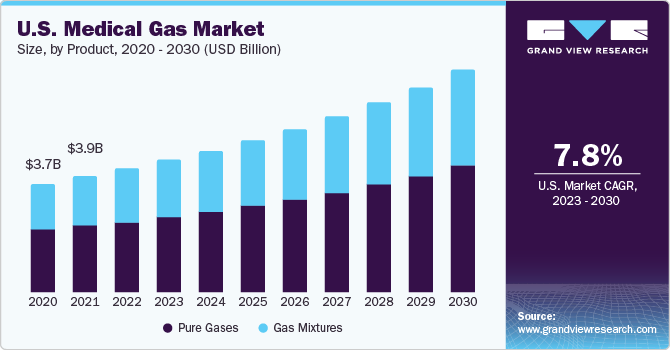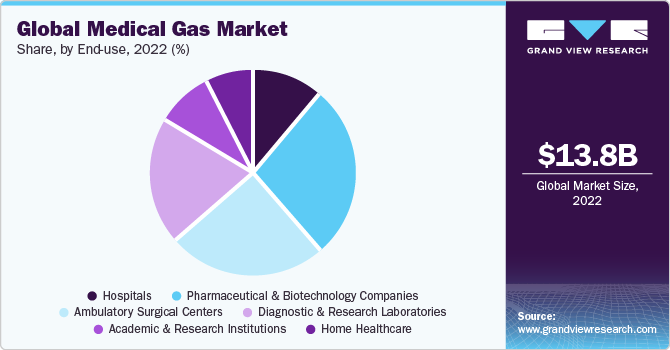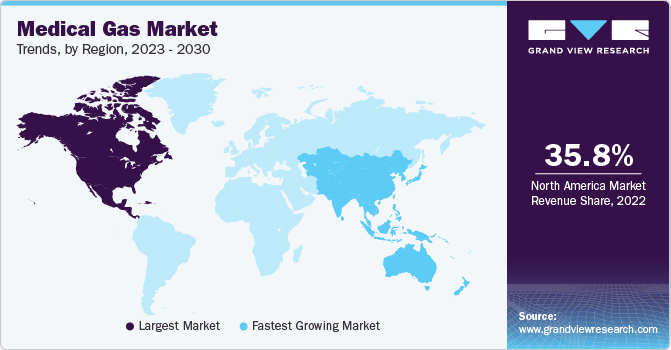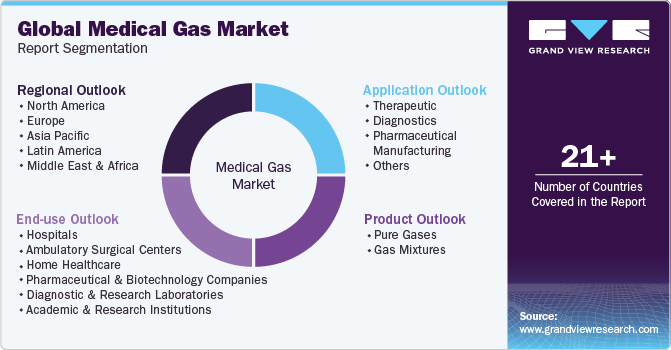- Home
- »
- Medical Devices
- »
-
Medical Gas Market Size, Share And Growth Report, 2030GVR Report cover
![Medical Gas Market Size, Share & Trends Report]()
Medical Gas Market Size, Share & Trends Analysis Report By Product (Pure Gases, Gas Mixtures), By Application (Therapeutic, Diagnostics), By End-use (Hospitals, Home Healthcare), By Region, And Segment Forecasts, 2023 - 2030
- Report ID: 978-1-68038-125-2
- Number of Report Pages: 90
- Format: PDF, Horizon Databook
- Historical Range: 2018 - 2021
- Forecast Period: 2023 - 2030
- Industry: Healthcare
Medical Gas Market Size & Trends
The global medical gas market size was valued at USD 13.75 billion in 2022 and is projected to expand at a compound annual growth rate (CAGR) of 8.14% from 2023 to 2030. The rising prevalence of chronic diseases, and advantageous initiatives commenced by government organizations, are key factors driving the market. Moreover, the growing geriatric population and rising demand for home healthcare and point-of-care products are some of the additional factors driving the market.

The rising prevalence of Chronic Respiratory Diseases (CRDs) such as Asthma, chronic obstructive pulmonary disease, occupational lung diseases, and pulmonary hypertension is driving the demand for medical gases. According to World Health Organization (WHO), Chronic Obstructive Pulmonary Disease (COPD) was responsible for approximately 3.23 million deaths globally in 2019. Moreover, as per the same source, Asthma, a major non-communicable disease, nearly affected 262 million people in 2019 and was responsible for 455,000 deaths. Medical gases such as oxygen, lung gas mixtures, and heliox are used extensively in treating and diagnosing these respiratory disorders.
Oxygen aids in preventing pulmonary artery hypertension, and its long-term usage might help relieve the strain on the heart. Thus, the rising prevalence of respiratory diseases is propelling the market forward. The market was significantly impacted due to the COVID-19 pandemic. The pandemic had led to shortages of medical oxygen owing to its increased demand that, had eventually caused major disruption in the oxygen market and supply chain breaks. For instance, per the data published in Business Standard Private Ltd., before the pandemic, the demand for liquid medical oxygen (LMO) in India was 700 tons per day (TPD). During the first wave of Covid-19, the demand for LMO increased fourfold to 2,800 TPD. Furthermore, with the second wave, demand has increased more than seven times that of the pre-Covid-19 levels - 5,000 TPD.
Similarly, according to a European Industrial Gases Association (EIGA) survey, members like Air Liquide and Linde are witnessing 5-10 times the normal demand for medical oxygen. Air Liquide had seen 4-6 times the average demand for medical oxygen in Italy and Eastern France. Thereby, owing to the aforementioned factors, the market witnessed a high boom in growth.
Furthermore, the pandemic also led to the development of innovations to aid in oxygen treatment for the large number of people suffering from respiratory diseases. Additionally, the rising adoption of home healthcare can propel the market post-COVID-19. Moreover, the growing number of FDA approvals for medical gas equipment is also encouraging market growth. The Food and Drug Administration (FDA) is proposing to update its Current Good Manufacturing Practice (CGMP) rules to include new color, labeling, design, and devotion requirements for medical oxygen gas compartments and closures. These standards are intended to make the contents of medical oxygen gas cylinders more easily identifiable, limit the risk of containers of industrial or other gases being incorrectly associated with medical oxygen supply systems, and reduce the risk of medical gas pollution.
The growing aging population susceptible to chronic conditions is foreseen to drive the demand for medical gases indirectly. The aging population is more vulnerable to chronic diseases owing to weakened immune responses. According to the WHO statistics, in 2020, the number of people aged above 60 years was more than the number of children younger than five years. According to the same source, in 2021, the global population of adults aged 60 and above might nearly double (2.1 billion) by 2050. Moreover, the number of persons aged 80 years or older is likely to reach 426 million by 2050. As a result of the large increase in the geriatric population, the prevalence of respiratory conditions has increased. For instance, as per the Princeton Health Care Center data, around 15.0% of older adults have Asthma, Chronic Obstructive Pulmonary Disease (COPD), or other respiratory disorders. Such facts and figures show that the demand for oxygen supply is expected to surge, which may drive the market throughout the forecast period.
Mounting demand for home healthcare and point-of-care diagnostics markets is anticipated to boost the market by triggering a rise in demand for packaged medical-grade gases (such as oxygen). In July 2012, the U.S. Congress passed a bill implementing the Food and Drug Safety and Innovation Act. This act is expected to serve this market as a driver during the forecast period owing to eliminating drug user fees for medical gas manufacturers and establishing a standard certification process for medical gas, among others.
Product Insights
The pure gases segment held the largest market share of over 55% in terms of revenue in 2022. The increasing number of patient hospitalizations, rising prevalence of chronic diseases, and road accidents worldwide are major factors driving the segment expansion. For instance, per the United Nations 2021 statistics, road accidents account for 1.3 million yearly deaths. Similarly, as per WHO, between 20 to 50 million people are injured every year, with many of them getting permanent disability due to road accidents. As a result of the rising number of road accidents, the need for oxygen therapy in various life care settings is increasing exponentially.
In pure gases, the oxygen segment is expected to witness the fastest CAGR of 8.30% during the forecast period. Oxygen is a base for all modern anesthetic procedures and life support for artificially ventilated patients because it plays an important part in respiratory support. In several conditions such as cyanosis, COPD, ventilators during anesthesia, shock, severe bleeding, respiratory/cardiac arrest, and significant trauma, the gas is critical in restoring tissue oxygen tension by increasing oxygen availability.
Oxygen is typically delivered in gas cylinders and is administered to patients using a facial mask that can hold around 60% of the oxygen or a tight-fitting anesthetic-type mask that can hold up to 100% of the oxygen. Furthermore, according to the Pharma Review, 20-40% oxygen is commonly used in the treatment of COPD, 40-60% oxygen is used in the treatment of bronchial asthma, and 100% oxygen is utilized in the treatment of severe hypoxia and noxious gas poising, all of which are propelling this segment's growth. In addition, patients admitted to intensive care units (ICUs) and ambulatory care for numerous surgeries require oxygen gas for life support. Thereby, owing to its high usability and demand, the segment is likely to dominate the market over the forecast period.
The medical air segment is expected to witness a CAGR of 7.96% during the forecast period, owing to its varied use in treating and managing patients. Medical air is used in nebulizers for respiratory therapy and humidity treatment. Medical air is given to patients with a delicate respiratory system susceptible to oxygen toxicity. Moreover, it is mainly used in ICU and NICU. Thus, due to the aforementioned factors, the market is expected to witness a high growth rate over the forecast period.
The gas mixtures segment is expected to grow at the fastest CAGR of 8.30% over the forecast period owing to its increasing use in therapeutic and diagnostic applications. Lung diffusion mixtures held the largest market revenue in 2022 as they are used to calibrate analytical instruments that detect the quantity of carbon monoxide distributed in the lungs and pulmonary function testing. These are diagnostic tests used in fields including intensive care, neonatal care, rehabilitation, wellness, disability assessments, and the diagnosis of respiratory, gastrointestinal, and cardiovascular system diseases.
During a pulmonary function test, the patient inhales a lung diffusion mixture containing a small amount of carbon monoxide. The breath of the patient is measured to see how thoroughly the carbon monoxide has dispersed in the lungs. The helium component of the lung diffusion mixture determines the lung volume. Thus, owing to its wide applicability and rising prevalence of respiratory disorders, the segment is expected to grow significantly in the forecast period.
Application Insights
The therapeutic application segment held the largest market share of around 40% in terms of revenue in 2022 owing to a broad range of medical gases used to treat and manage various disease conditions. Gases utilized for therapeutic purposes are classified as medicines and must meet stringent purity and quality requirements. Therapeutic gases mainly include oxygen, medical air, nitric oxide, carbon dioxide, and mixtures of helium and oxygen. Medical oxygen is widely used in all healthcare settings, from anesthesia to inhalation therapy.
Medical nitrous oxide is used for anesthesia, pain relief, inflating the abdominal cavities during a laparoscopy, and as a refrigerant in cryosurgery. In minimally invasive surgery (laparoscopy, endoscopy, and arthroscopy), carbon dioxide is frequently utilized as an insufflation gas to widen and stabilize body cavities in order to enhance the visibility of the operating area. Helium is a gas that is used in breathing mixtures for patients with weakened lungs. Significant advancements in the therapeutic uses of medical gases have resulted in an uptick in medical gas usage for a wide range of clinical applications.
The diagnostics segment is expected to grow at the fastest CAGR of 8.77% during the forecast period. This growth is attributable to its rising use in medical imaging and general laboratory applications. Controlled aerobic or anaerobic incubator environments for biological cell culture or tissue growth are among the culture growth applications used in laboratories. Controlled aerobic conditions are made with oxygen-rich mixtures, whereas anaerobic conditions are produced with hydrogen or carbon dioxide-rich mixtures.
Moreover, they are usually used for patient diagnostics such as blood gas analysis and lung function testing. For instance, liquid helium is required in MRI to cool down superconductive magnet coil scanners. In addition, test gases are utilized to calibrate and maintain medical instruments that provide anesthetic gases. Thus, varied usage of these gases in diagnostics is expected to propel segment growth.
End-use Insights
The hospital segment dominated the market and accounted for a revenue share of 28.6% in terms of revenue and it is also expected to grow at the fastest CAGR of 8.69% during the forecast period. In hospitals, all types of commercially available medical gases such as oxygen (O2), nitrogen (N2), medicinal air, carbon dioxide (CO2), and nitrogen protoxide (N2O), are widely used. The use of medical gases in medical procedures such as surgeries, intensive care, and emergency response, as well as the high prevalence of medical procedures performed worldwide, contribute to the segment's dominance. For instance, every year, more than 2 million people receive medical oxygen. According to the National Health Service, approximately 17.5% of hospital patients in the UK are receiving oxygen at any given time, which equates to around 18,000 patients every day. Moreover, as per a research article published in MDPI (2018), the annual consumption per hospital bed was computed as 350 m3 for oxygen, 325 m3 for medicinal air, 9 m3 for nitrogen protoxide, and 3 m3 for carbon dioxide.

The home healthcare segment is expected to witness a significant growth rate during the forecast period. The trending shift from hospital to home care is a key enabler of this segment's growth. In line with this trend, regulatory bodies are gradually paving the way for a robust establishment of this segment. Patients with a variety of respiratory illnesses, such as pneumonia, COPD, and lung cancer, are also gravitating toward portable devices. This will increase demand for the product in-home care settings. Technological innovations have expanded the functionality options for numerous medical gas handling equipment used in-home care. The advent of lightweight and portable medical gas handling equipment has proven to be a boon to the home healthcare market's growth.
Furthermore, in the last five years, medical gas cylinder technology has advanced remarkably. Lightweight, non-limited life (NLL) composite cylinders have recently hit the market and are forecasted to play a significant role in the development of innovative homecare treatments, portable oxygen therapies, and medical gas applications in the coming years. These products offer considerable benefits to patients in the homecare setting, addressing the end user's desire for a lightweight cylinder that is far lighter than aluminum cylinders. Thereby, such advancements in medical gas equipment are contributing to fueling the market growth.
Regional Insights
North America dominated the global medical gas market and accounted for a revenue share of 35.8% in 2022 and is expected to witness a considerable growth rate over the forecast period. This steady growth is attributed to the rising use of medical gases in the treatment of respiratory diseases such as COPD and asthma. The rising prevalence of COPD, asthma, and other medical conditions such as cardiovascular and lifestyle-related diseases are predicted to drive demand for medical gases in the U.S. during the projected timeline. Moreover, the presence of cutting-edge healthcare facilities, particularly intensive care units, a well-established market, and a growing geriatric population have all contributed to the U.S. capturing the major share of the market.

In addition, the medical gas sector in the U.S. is undergoing a shift in standards, analysis, and delivery procedures as a result of the current increase in the use of home oxygen therapy, which is leading to the modernization of medical gas standards and the means of supply. In terms of market share, North America was closely followed by Europe, which is expected to grow at a CAGR of 8.08% over the forecast period. The presence of numerous associations such as the EIGA (European Industrial Gases Association) and MGA (Medical Gas Association), that enable providing standard rules and regulations for medical gas manufacturers is one of the major factors contributing to the growth of this region.
In addition, the Medicines and Healthcare Products Regulatory Agency (MHRA), which is an Executive Agency of the Department of Health and Social Care (DHSC), is the UK regulator for medical gases in the UK. The MHRA protects and encourages public health and patient safety by ensuring that medicines, healthcare products, and medical equipment fulfill appropriate safety, quality, performance, and effectiveness standards and are used adequately. Furthermore, the expansion of the market in this region is being fueled by an increase in the number of hospitals, as well as an increase in the use of home healthcare settings in nations such as the UK, France, Italy, and others. According to the WHO, the region's life expectancy has increased in recent decades. In the coming years, the rising number of care-dependent elderly people in Europe is predicted to radically change the home care settings business in Europe, which can indirectly benefit the market.
Asia Pacific is expected to grow at the fastest CAGR of 8.7% over the forecast period. The presence of highly populated emerging economies such as India and China are expected to be the reason for the growth of the market in the region. Moreover, the region is witnessing a rise in investments in the market. For instance, In May 2023, INOX Air, a leading industrial and medical gas producer in India, announced an investment of approximately USD 364 million by 2025, considering the rising demand in the market.
Key Companies & Market Share Insights
The market is moderately consolidated, owing to the presence of a few key players in the market. Furthermore, leading players are involved in collaborations, product launches, mergers, and acquisitions to strengthen their product portfolios. For instance, in March 2023, Atlas Copco acquired FS Medical’s operating assets, which include medical & laboratory gas equipment as well as systems. This acquisition is expected to boost the support and service footprint of Atlas Copco. In January 2022, NOVAIR announced the acquisition of Oxygen Generating Systems Intl. This acquisition is anticipated to increase the company’s manufacturing capacity and global footprint. In June 2021, Air Liquide S.A. agreed to purchase South Africa's largest oxygen-producing facility. Sasol and Air Liquide strategically made a deal for Air Liquide to buy and operate the plant. This strategy is expected to boost the firm’s overall manufacturing capacity and strengthen its market position. Thus, with various strategies acquired by leading players, the market is expected to impel during the forecast period.
Key Medical Gas Companies:
- Linde plc.
- Air Liquide
- Atlas Copco
- Messer
- Air Products and Chemicals Inc.
- TAIYO NIPPON SANSO CORPORATION
- Matheson Tri-Gas Inc.
- INOX-Air Products Inc.
Medical Gas Market Report Scope
Report Attribute
Details
Market size value in 2023
USD 14.77 billion
Revenue forecast in 2030
USD 25.55 billion
Growth rate
CAGR of 8.14% from 2023 to 2030
Base year for estimation
2022
Historical data
2018 - 2021
Forecast period
2023 - 2030
Report updated
December 2023
Quantitative units
Revenue in USD million and CAGR from 2023 to 2030
Report coverage
Revenue forecast, company ranking, competitive landscape, growth factors, and trends
Segments covered
Product, application, end-use, region
Regional scope
North America; Europe; Asia Pacific; Latin America; MEA
Country scope
U.S.; Canada; U.K.; Germany; France; Italy; Spain; Denmark; Sweden; Norway; Japan; China; India; Australia; South Korea; Thailand; Brazil; Mexico; Argentina; Saudi Arabia; South Africa; South Africa; UAE; Kuwait;
Key companies profiled
Linde plc.; Air Liquide; Atlas Copco; Messer; Air Products and Chemicals Inc.; TAIYO NIPPON SANSO CORPORATION; Matheson Tri-Gas Inc.; INOX-Air Products Inc.
Customization scope
Free report customization (equivalent up to 8 analysts working days) with purchase. Addition or alteration to country, regional, and segment scope.
Pricing and purchase options
Avail customized purchase options to meet your exact research needs. Explore purchase options
Global Medical Gas Market Report Segmentation
This report forecasts revenue growth at global, regional, and country levels and provides an analysis of the latest industry trends in each of the sub-segments from 2018 to 2030. For the purpose of this study, Grand View Research has segmented the global medical gas market report on the basis of product, application, end-use, and region:

-
Product Outlook (Revenue, USD Million, 2018 - 2030)
-
Pure Gases
-
Medical Air
-
Oxygen
-
Nitrous Oxide
-
Nitrogen
-
Carbon Dioxide
-
Helium
-
-
Gas Mixtures
-
Aerobic Gas Mixtures
-
Anaerobic Gas Mixtures
-
Blood Gas Mixtures
-
Lung Diffusion Mixtures
-
Medical Laser Mixtures
-
Medical Drug Gas Mixtures
-
Others
-
-
-
Application Outlook (Revenue, USD Million, 2018 - 2030)
-
Therapeutic
-
Diagnostics
-
Pharmaceutical Manufacturing
-
Others
-
-
End-use Outlook (Revenue, USD Million, 2018 - 2030)
-
Hospitals
-
Ambulatory Surgical Centers
-
Home Healthcare
-
Pharmaceutical and Biotechnology Companies
-
Diagnostic and Research Laboratories
-
Academic and Research Institutions
-
-
Regional Outlook (Revenue, USD Million, 2018 - 2030)
-
North America
-
U.S.
-
Canada
-
-
Europe
-
U.K.
-
Germany
-
France
-
Italy
-
Spain
-
Sweden
-
Norway
-
Denmark
-
-
Asia Pacific
-
Japan
-
China
-
India
-
Australia
-
Thailand
-
South Korea
-
-
Latin America
-
Brazil
-
Mexico
-
Argentina
-
-
Middle East & Africa
-
Saudi Arabia
-
South Africa
-
UAE
-
Kuwait
-
-
Frequently Asked Questions About This Report
b. The global medical gas market size was estimated at USD 13.7 billion in 2022 and is expected to reach USD 14.7 billion in 2023.
b. The global medical gas market is expected to grow at a compound annual growth rate of 8.14% from 2023 to 2030 to reach USD 25.5 billion by 2030
b. North America dominated the medical gas market with a share of 35.8% in 2022. This is attributable to the increasing geriatric population along with the increasing prevalence of chronic diseases in the region.
b. Some key players operating in the medical gas market include Linde plc; Messer; Atlas Copco; Air Products Inc.; Air Liquide; Taiyo Nippon Sanso Corporation and Matheson Tri-Gas Inc.
b. Key factors that are driving the medical gas market growth include the rising prevalence of chronic diseases, and advantageous initiatives commenced by government organizations, are key factors driving the medical gas market's expansion. Moreover, the growing geriatric population and rising demand for home healthcare & point-of-care products are some of the other factors responsible for the growth of the medical gas market.
Share this report with your colleague or friend.
![gvr icn]()
NEED A CUSTOM REPORT?
We can customize every report - free of charge - including purchasing stand-alone sections or country-level reports, as well as offer affordable discounts for start-ups & universities. Contact us now
![Certified Icon]()
We are GDPR and CCPA compliant! Your transaction & personal information is safe and secure. For more details, please read our privacy policy.
We are committed towards customer satisfaction, and quality service.
"The quality of research they have done for us has been excellent."





